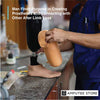Revolutionizing Prosthetics With Fabric-Based Sensors
Reading Time: 4 minutes
The key to ensuring comfort when wearing a lower-limb prosthesis, besides prosthetic socket fit, is ensuring that the residual limb loads symmetrically. However, there is no way to monitor residual limb loading in real time. But that may soon change with a fabric-based sensor currently being developed by engineers at the University of Delaware (UD).

What is limb loading?
When a residual limb loads correctly, the weight and forces from the body are transferred and distributed through the residual limb during movement, particularly when wearing a prosthetic limb.
For a prosthesis to work effectively, the residual limb needs to handle loads in a way that distributes forces evenly, maximizes comfort and function, ensures proper alignment, and prevents skin irritation or breakdown.
Proper loading allows the residual limb to support the body's weight during weight-bearing activities, like walking, standing, or running, without causing discomfort or fatigue.
The study
The pilot study aims to test the potential of fabric-based sensors in monitoring residual limb load.
The fabric-based sensors were developed by Jill Higginson, a George W. Laird Professor of Mechanical Engineering; Erik Thosthenson, a professor of mechanical engineering in UD’s College of Engineering; and Sagar Doshi, an associate scientist in UD’s Center for Composite Material. Higginson also led the study.
The one who tested the sensors was John Horne, who lost his right leg to bone cancer when he was a high school freshman. He’s currently the president of Independence Prosthetics-Orthotics, a provider of excellent prosthetic and orthotic care in Delaware and the surrounding Philadelphia area.
Horne showed that the small, fabric-like sensors ought to be placed within the pylon of the prosthetic leg. To test the device, he walked on a treadmill equipped with force plates to determine if the treadmill data aligned with the sensors' readings.
Benefits of wearable pressure sensors
In an interview with UDaily, Higginson explained that the fabric-based sensors can help healthcare teams monitor loads and gauge real-world performance, which would be great for people with lower limb loss.
In the same interview, Horne expounded that the issue with asking patients how a prosthetic device makes them feel is tricky. It’s tough to translate how a patient is feeling. So, technology like the fabric-based sensor can give clinicians hardcore data so they can understand what’s happening within the prosthetic socket and make the appropriate changes.
According to Hanna Armstrong, a biomedical engineering graduate at UD, clinicians only know if something is wrong with a person’s prosthetic when they’re in pain. This could now change with the fabric-based pressure sensor.
Devices like this could also help patients who lack access to healthcare. For example, the wearable sensor could generate data from patients with prosthetic issues in rural areas. Then, clinicians could adjust the prosthetic limb remotely.
In addition, the use of this technology extends beyond the amputee population. It could potentially benefit elite athletes. For example, Higginson explained the sensor could help a figure skater see if they’re using the proper push-off force for various jumps. A golf player could also determine whether their limbs are loading properly during their swing.
Next steps
Once the pilot study is complete, a clinical trial could commence. A clinical trial will better gauge the sensors’ effectiveness, critical to gaining insurance acceptance. A clinical trial would also make it easier to commercialize the sensors.
The hope is that this innovative technology will transform prosthetic care and foster greater accessibility to quality healthcare for all patients, regardless of their location. The future of prosthetics looks promising.










































































